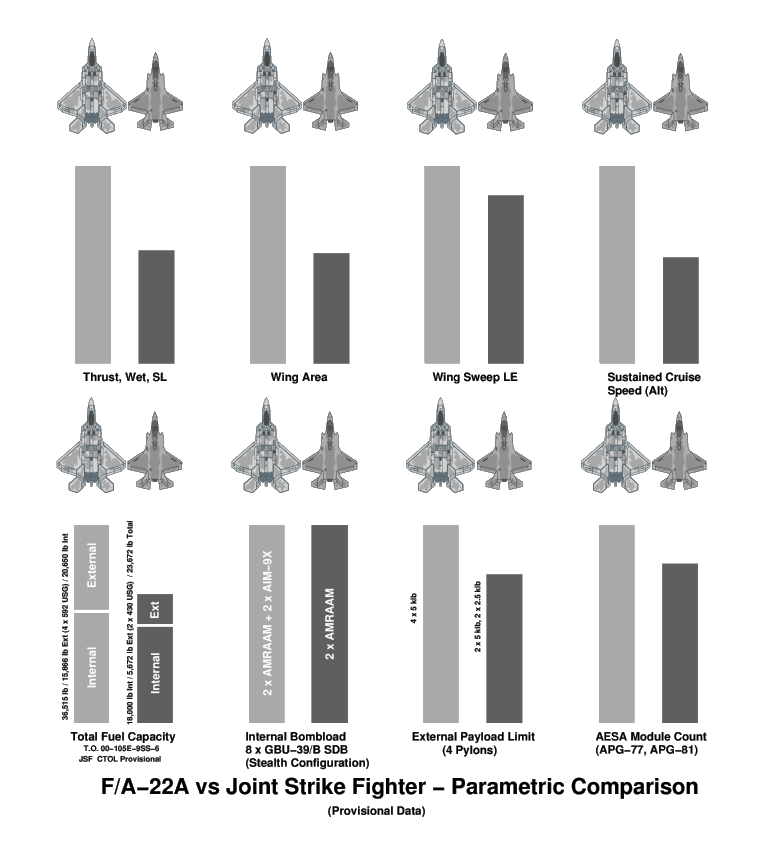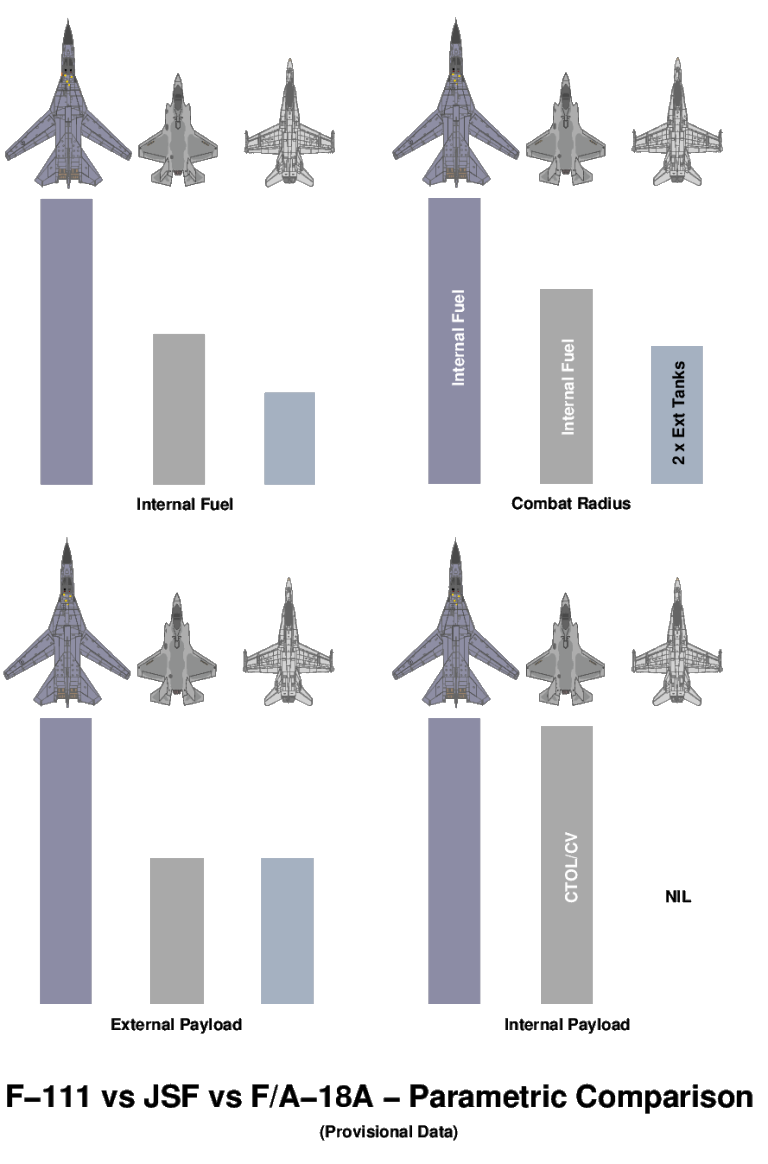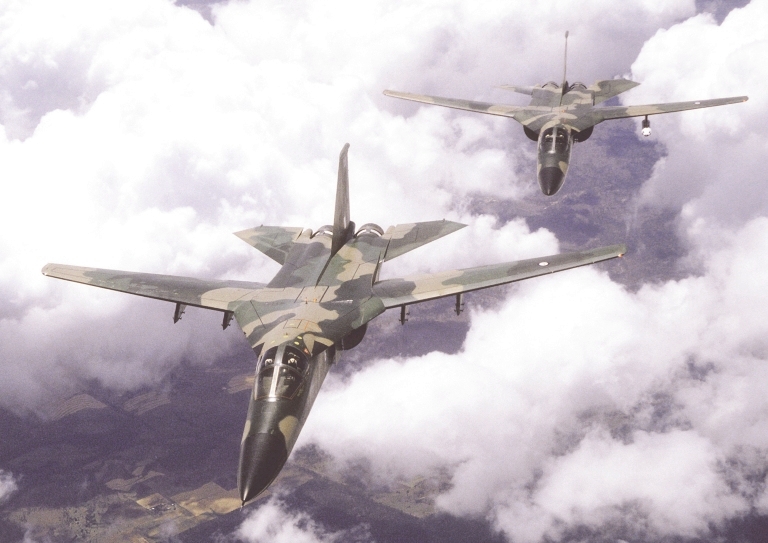Introduction
The plan for premature
retirement of the RAAF's F-111 fleet is the most far reaching force
structure change for the RAAF, and the ADF as a whole, seen for many
decades. As such it will have significant consequences for the RAAF
many
of which are not widely understood, even in RAAF circles.
For three decades the F-111 has been the
backbone of the RAAF combat fleet, providing a strike capability with
no
peer in this region. In context, Australia's thirty plus F-111s provide
around 50% of the RAAF's aggregate strike capability, and a long range
and persistent precision guided munitions delivery capability without
aerial refuelling tanker support. In budgetary terms, the F-111
capability is a bargain, costing around 3.5% of the annual Defence
budget to operate. Providing the equivalent capability using smaller
fighters like the F/A-18A or JSF supported by tankers typically costs
around 70% more, per aimpoint hit, than using the F-111. Removal of the
F-111 chops down RAAF strike capability against the White Paper goal of
four years ago by 40% - if we believe Air Force leadership statements –
or closer to 60% if we employ hard quantitative measures.
Much has been said and written about
this issue, in the broadcast media, trade press, daily press and in
parliamentary committee submissions. That the debate has attracted such
interest, and persisted for over a year now without abating, indicates
very clearly that there is little enthusiasm for the early retirement
of
the F-111 outside the corridors of Russell Offices. Indeed, with the
exception of a handful of advocates largely associated with the current
Air Force leadership, there are very few who would support the decision.
What has emerged over 12 months of
public debate on this issue is that the case brought against the F-111
last year was centred entirely in non-sequitur arguments,
mis-interpretations of technological and regional trends, and a good
number of myths accepted as fact within the Defence bureaucracy. That a
decision of such strategic importance to the nation was sold to Cabinet
on the basis of so defective a rationale raises good questions about
the
intellectual rigour underpinning the whole plan for the future of the
RAAF.
The current budgetary allocation for the
replacement of the F-111 and F/A-18A with new combat aircraft now sits
roughly at A$12bn to $15bn, putting it in the category of more than ten
Snowy Mountain hydroelectric schemes, five North West Shelf gas
production schemes or ten Adelaide-Darwin railroad schemes. Decisions
of
such magnitude should not and cannot be made without a deep and
comprehensive analytical process. Yet what we have observed with the
F-111 and JSF decisions have been essentially arbitrary recommendations
to Cabinet, justified a posteriori with an ever evolving gaggle
of 'why we had to do this' public claims.
RAAF Force Structure Planning Myths
The current plan for the RAAF's future
is articulated in an Air Force submission to the JSCFADT entitled 'Air
Combat Capability' and a subsequent ASPI Strategic Insight paper by the
Chief of Air Force. This scheme envisages the effective close-down of
F-111 upgrades after the current Block C-4 Mil-Std-1760/AGM-142
upgrade,
and early retirement of the F-111 in 2010, contingent on the
introduction of A330-200 tankers and new PGMs on the F/A-18A and AP-3C
by that date. The JSF is currently the sole contender for the NACC
program, with a decision to purchase being pushed for 2006, the year
the
first JSF 'production' prototypes are to fly. While the Defence
leadership claim escape points in 2006 for the JSF decision, and 2010
for the F-111 decision, the reality is that the necessary provisions to
effect such escape manoeuvres are not being performed, making both
decisions effectively fait accompli outcomes.
In the framework of the high risk JSF
decision, the only viable long term alternatives to this aircraft are
the more capable F/A-22A, and its yet to materialise larger offspring,
the FB-22A 'regional bomber'. In practical terms, the choices for
replacing the F/A-18A with a new type distill down to the JSF or the
F/A-22A, while the F-111 could be further life extended, or replaced
with more F/A-22As, JSFs or likely FB-22As, should they materialise.

The case for purchasing the JSF over the F/A-22A as an F/A-18A
replacement has been predicated on two basic assumptions. The first is
that provision of supporting Intelligence Surveillance Reconnaissance
(ISR) and networking capabilities will provide a persistent assymetric
advantage over competing AWACS supported regional Su-27, Su-30 and
subsequent Flanker derivatives, which now are likely to include AL-41F
powered subtypes with supersonic cruise capability. The second
assumption is that the JSF will provide an 'F/A-22A-like' capability at
much lower cost, inside a viable timeline. Neither of these assumptions
is now intellectually supportable, nor were they supportable when the
JSF idea was hatched – they are little more than myths.
The battlefield air interdiction and
close air support optimised JSF cannot substitute for the air dominance
and deep strike optimised F/A-22A in anything but a benign environment.
In kinematic performance the JSF was optimised around the performance
envelope of the F-16C and F/A-18, aircraft the Su-27/30 was built to
kill. The F/A-22A has a sustained supersonic cruise capability, and is
built to cover the kinematic performance envelope of an afterburning
F-15 - or Su-27/30 - on dry engine thrust alone.
In stealth capabilities, the JSF is
shaped to perform best in the forward sector, and mostly in the
centimetric radar bands, to defeat battlefield air defence threats and
solo fighters. The F/A-22A was designed to defeat centrimetric and
decimetric band radars, from all aspects, this encompassing fighters,
long range SAMs and AEW&C radars. The F/A-22A's large APG-77 radar
has around twice the effective coverage footprint of the strike
optimised APG-81 in the JSF.

In the strike domain, currently funded
and planned avionics and weapons for production F/A-22As cover most of
the capabilities in the JSF. While the F/A-22A is limited to the same
basic internal GBU-39/B Small Diameter Bomb payload as the JSF, but
with
twice as many air-air missiles carried, it has much greater external
payload capacity, and fuel capacity.
Available budgetary data indicates that
around 70 F/A-22A could be bought for the cost of 100 JSFs in the
timescale of interest – Defence leadership claims otherwise amount to
little more than further mythology.
The prevalence of myths and non-sequitur
reasoning observed in relation to the JSF vs F/A-22A issue, and the
networking / ISR issues, are sadly also observed in the rationale for
early F-111 retirement.

The F-111 is presented as old,
maintenance intensive, technologically obsolete, uncompetitive due to
the absence of networking, and presenting unspecified risks of age
related fleet loss.Yet there is no hard evidence to support these
arguments, and what little has been presented conflicts with hard data.
The F-111 remains a world class strike
asset, with unmatched aerodynamic performance and a very modern core
avionic system. It has range performance which permits significant
economies in tanker numbers, and the large payload and persistence
which
is vital for battlefield interdiction in a networked environment.
A good example of mythology lies in the
three alleged 'surprises' resulting in F-111 fleet groundings,
specifically leaking fuel tanks, wing fatigue related replacement and
the fuel tank wiring induced explosion in A8-112. All were byproducts
of
long known about failures in maintenance and support planning and
management, and all have since been corrected. With over 200 mothballed
AMARC F-111s to raid for structural and system components, the option
of
structural and system component replacements with new, and an ageing
aircraft engineering program in place, the F-111 could be maintained
well beyond 2020, no differently than the B-52H and B-1B, both
scheduled
for 2035+ retirement.
No less dubious is the myth that
networking equipment would be expensive to introduce in the F-111 – the
whole fleet could be fitted with JTIDS/MIDS terminals for an outlay of
the order of A$20M to 30M.
Mythology about the F-111 has not been
confined to supportability and networking alone – virtually all public
statements have avoided discussing the Mil-Std-1760 weapons capability
paid for and now being fitted in the F-111C Block 4 upgrade. With Block
C-4, virtually all of the weapons planned for the JSF and F/A-22A could
be integrated on the F-111 for the cost of software and clearances
alone.
The case for the JSF over the F/A-22A,
and the case for early F-111 retirement are not intellectually
supportable by the evidence.
Adverse Consequences of Early F-111
Retirement
If the current JSF-centric plan for the
RAAF is pursued further, and the F-111 drawdown and 2010 retirement are
implemented, the RAAF becomes exposed to some significant strategic
risks, and also loses what choices it still has today in long term
force
structure options.
The greatest risk lies in the JSF
itself, both in terms of its ability to address future capability
needs,
and in its delivery timelines and costs.
The issue of JSF capabilities, costs and
delivery timelines remains to a large extent in a state of flux, as the
aircraft has yet to transition past the 'risk hump' in development.
Until a definitive production configuration of each of the JSF variants
enters Low Rate Initial Production (LRIP) later this decade, the
aircraft's exact performance parameters and costs will remain
uncertain.
What is clear is that in 2012 we can at best expect to see expensive
early build LRIP airframes, likely requiring extensive block upgrades
later in the decade to bring them up to the then current production
configuration. Weight issues remain hotly debated in the US, especially
for the STOVL variant, which recently reverted to the smaller bomb bay
configuration originally planned for STOVL/CTOL vs the larger bomb bay
originally planned only for the CV variant.
The US Air Force recently stated its
intention to restructure its JSF buy of CTOL aircraft to a mix
including
'hundreds' of STOVL airframes, possibly with further unique design
features, to better support Army divisions with expeditionary CAS/BAI
capability. This decision will impact the cost and timelines in the JSF
program, as the USAF STOVL buy reduces the total number of CTOL JSFs
built, and pushes a larger fraction of the total build into the
timeframe of the STOVL JSF variant build. Given a fixed US Air Force
JSF
production budget, with average projected STOVL JSF flyaway cost around
30% higher than CTOL flyaway cost, the total number of JSFs built would
be reduced further increasing unit flyaway cost across all subtypes.
The combined effect of total JSF build number reduction will thus
increase JSF flyaway costs, and drive up the cost of CTOL JSFs built
early in the production cycle – exactly when the RAAF intends to buy
them.
In the simplest of terms, the LRIP CTOL
JSFs which might be available to meet the RAAF's intended 2012
introduction will be become more expensive than expected six months
ago,
further narrowing the cost gap between the F/A-22A and the JSF.
The publicly stated 'hedging strategy'
for the RAAF is to provision for centre barrel replacements of around
60% of the F/A-18A fleet, to extend their structural life. Hornet
centre-barrel replacement is a time consuming and expensive task, as
the
aircraft must be structurally pulled apart, the centre-barrel replaced
and the whole aircraft then reassembled in a jig. The whole effort can
see an F/A-18A in the depot for up to 12 months, subject to the
resourcing of the rebuild, a very different proposition from the mere
days of downtime required to swap a wing-set on the F-111. What comes
out of the F/A-18A rebuild is the same aircraft with around one sixth
of its structure zero timed, but with existing capability limitations.
Given the prospect of late running and
more expensive JSFs post 2012, the latter itself possibly impacting
delivery schedules, the RAAF faces the real likelihood of rebarrelling
a
large fraction of the F/A-18A fleet during this period, at a cost of
hundreds of millions. We thus observe a 50% order of magnitude
capability loss with F-111 retirement in 2010, followed by a period in
which a good fraction of the remaining F/A-18As are unavailable due to
rebuilds. If we measure basic force structure strength in terms of
total
uplift of a common weapon type to distance, we observe the RAAF falling
well below 40% of its current combat fleet strength. While the A330-200
tankers provide some offset in aggregate range/persistence lost, this
falls well below what is being thrown away with the F-111.

The alternative to this quagmire was
presented to Defence some years ago by Australian Industry in the
'Evolved F-111' unsolicited proposals, a model in which the F-111 was
upgraded and its service life extended past 2020 to permit acquisition
of 40 to 50 late build F/A-22As post 2012, as F/A-18A replacements,
thus
pushing F-111 replacement into the post 2020 timeframe. This model is
designed to manage and mitigate risks, spread budgetary outlays, avoid
a capability gap. Its opens up four alternative strategies for
replacing the capability in the F-111. These were further F-111 life
extension, following the B-1B/B-52H model, replacement with FB-22As, or
replacement with either more F/A-22As or JSFs, and additional tankers.
A
provision in this model was to swap 77 SQN from the F/A-18A to the
F-111F or upgraded F-111G, to spread the fatigue load accrual in the
F/A-18A fleet and extend fatigue life by around 30%. Early retirement
of
the F-111 destroys all of these alternatives, chops RAAF capability,
and drives Australia down the path of permanent capability reduction
in F/A-18A and later JSF-centric combat fleet models.
Conclusions
What we observe today in force structure
planning for the RAAF combat fleet, and its supporting rationale, is a
fundamental realignment to a force structure which priorities
battlefield air interdiction and close air support capabilities over
the long established doctrine of prioritising air superiority and
strategic strike capabilities. This unstated doctrine will expose
Australia to pressure by regional nations, and increase dependency on
US combat assets in an unprecedented fashion.
The reasoning which justifies this
change
is underpinned largely by mythology, as proper analysis was never
performed. Politically and strategically less painful alternatives
exploiting the F-111 and F/A-22A all vanish as the current JSF-centric
plan is implemented.
The future of the RAAF – and the
nation's long term strategic position in the region – will be decided
over the next eighteen months.
|
![Australia's First Online Journal Covering Air Power Issues [ISSN 1832-2433] Australia's First Online Journal Covering Air Power Issues [ISSN 1832-2433]](APA/APA-Title-Analyses.png)
![Sukhoi PAK-FA and Flanker Index Page [Click for more ...]](APA/flanker.png)
![F-35 Joint Strike Fighter Index Page [Click for more ...]](APA/jsf.png)
![Weapons Technology Index Page [Click for more ...]](APA/weps.png)
![News and Media Related Material Index Page [Click for more ...]](APA/media.png)
![Surface to Air Missile Systems / Integrated Air Defence Systems Index Page [Click for more ...]](APA/sams-iads.png)
![Ballistic Missiles and Missile Defence Page [Click for more ...]](APA/msls-bmd.png)
![Air Power and National Military Strategy Index Page [Click for more ...]](APA/strategy.png)
![Military Aviation Historical Topics Index Page [Click for more ...]](APA/history.png)
![Intelligence, Surveillance and Reconnaissance and Network Centric Warfare Index Page [Click for more ...]](APA/isr-ncw.png)
![Information Warfare / Operations and Electronic Warfare Index Page [Click for more ...]](APA/iw.png)
![Systems and Basic Technology Index Page [Click for more ...]](APA/technology.png)
![Related Links Index Page [Click for more ...]](APA/links.png)
![Australia's First Online Journal Covering Air Power Issues [ISSN 1832-2433] Australia's First Online Journal Covering Air Power Issues [ISSN 1832-2433]](APA/APA-Title-Analyses.png)
![Sukhoi PAK-FA and Flanker Index Page [Click for more ...]](APA/flanker.png)
![F-35 Joint Strike Fighter Index Page [Click for more ...]](APA/jsf.png)
![Weapons Technology Index Page [Click for more ...]](APA/weps.png)
![News and Media Related Material Index Page [Click for more ...]](APA/media.png)
![Surface to Air Missile Systems / Integrated Air Defence Systems Index Page [Click for more ...]](APA/sams-iads.png)
![Ballistic Missiles and Missile Defence Page [Click for more ...]](APA/msls-bmd.png)
![Air Power and National Military Strategy Index Page [Click for more ...]](APA/strategy.png)
![Military Aviation Historical Topics Index Page [Click for more ...]](APA/history.png)
![Intelligence, Surveillance and Reconnaissance and Network Centric Warfare Index Page [Click for more ...]](APA/isr-ncw.png)
![Information Warfare / Operations and Electronic Warfare Index Page [Click for more ...]](APA/iw.png)
![Systems and Basic Technology Index Page [Click for more ...]](APA/technology.png)
![Related Links Index Page [Click for more ...]](APA/links.png)


![Sukhoi PAK-FA and Flanker Index Page [Click for more ...]](APA/flanker.png)
![F-35 Joint Strike Fighter Index Page [Click for more ...]](APA/jsf.png)
![Weapons Technology Index Page [Click for more ...]](APA/weps.png)
![News and Media Related Material Index Page [Click for more ...]](APA/media.png)
![Surface to Air Missile Systems / Integrated Air Defence Systems Index Page [Click for more ...]](APA/sams-iads.png)
![Ballistic Missiles and Missile Defence Page [Click for more ...]](APA/msls-bmd.png)
![Air Power and National Military Strategy Index Page [Click for more ...]](APA/strategy.png)
![Military Aviation Historical Topics Index Page [Click for more ...]](APA/history.png)
![Information Warfare / Operations and Electronic Warfare Index Page [Click for more ...]](APA/iw.png)
![Systems and Basic Technology Index Page [Click for more ...]](APA/technology.png)
![Related Links Index Page [Click for more ...]](APA/links.png)
![Homepage of Australia's First Online Journal Covering Air Power Issues (ISSN 1832-2433) [Click for more ...]](APA/apa-analyses.png)